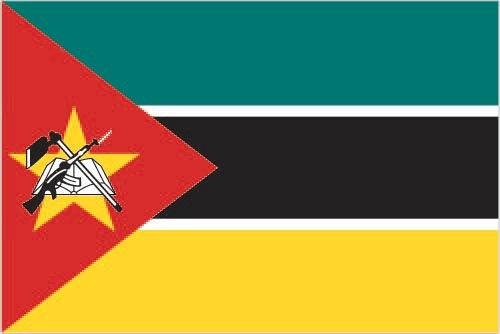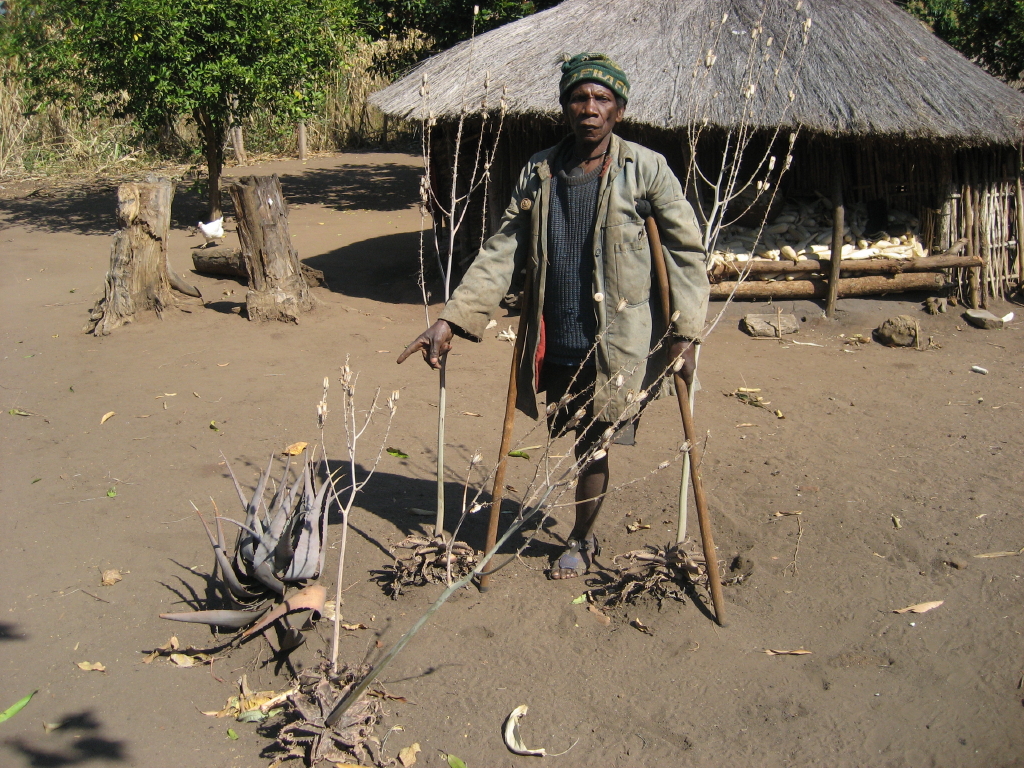212 Mozambique

Three equal horizontal bands of green (top), black, and yellow with a red isosceles triangle based on the hoist side. The black band is edged in white. Centered in the triangle is a yellow five-pointed star bearing a crossed rifle and hoe in black superimposed on an open white book. Green represents the riches of the land, white peace, black the African continent, yellow the country’s minerals, and red the struggle for independence. The rifle symbolizes defense and vigilance, the hoe refers to the country’s agriculture, the open book stresses the importance of education, and the star represents Marxism and internationalism.
Flag courtesy of the CIA World Factbook

Map courtesy of the CIA World Factbook

A land mine victim in Mozambique
Government
According to Britannica, the Mozambique Liberation Front (Frente de Libertação de Moçambique; Frelimo) led the armed insurgency against Portuguese colonial rule and came to power in 1975, at which time Mozambique became a people’s republic. Under the 1975 constitution, produced by the Central Committee of Frelimo, the party’s president served as the president of the country. The president was also the head of the Council of Ministers, the People’s Assembly, and Frelimo’s Central Committee, as well as the commander in chief of the armed forces. Since membership in Frelimo was a prerequisite for any political office, the most powerful national and provincial offices tended to circulate among a fairly small group of trusted party members.
Colonial legislation was allowed to stand unless it was specifically judged to contradict the spirit of the new constitution. Legislation and judicial principles and practice evolved piecemeal through the work of popular assemblies and popular tribunals. In the early 1980s, for example, capital offenses were expanded to include political and nonviolent crimes such as hoarding and smuggling, and public flogging was reintroduced.
A new constitution, which introduced major changes in the government, multiparty elections, universal adult suffrage, and the secret ballot, was adopted in November 1990. Presidential term limits were outlined; a parliament was established with limited ability to veto executive action; the death penalty was abolished; and freedom of the press, the workers’ right to strike, and the concept of habeas corpus were confirmed.
Under the 1990 constitution, which has been amended, the president serves as the head of state and government, is elected to a five-year term through universal suffrage, and can be reelected to a consecutive term only once. The president is assisted by the prime minister and the Council of Ministers. The president may also seek counsel from the Council of State, an advisory body provided for by a 2004 amendment to the constitution.
Members of the legislature, the Assembly of the Republic, are elected to five-year terms by universal suffrage. Among the Assembly’s powers are the ability to ratify the suspension of constitutional guarantees, approve the appointment of the president and deputy president of the Supreme Court, and grant amnesties and pardons.
For administrative purposes, Mozambique is divided into 10 provinces (Cabo Delgado, Niassa, Nampula, Zambézia, Tete, Sofala, Manica, Maputo, Inhambane, and Gaza) and the capital city of Maputo. The provinces are headed by governors who are chosen by the political party that wins the majority of seats in provincial assemblies. The provinces, in turn, are divided into districts and localities.
The judicial system consists of the Supreme Court, the Administrative Court, and lower courts. Judges are appointed by the president after consultation with the Superior Council of the Judiciary or the Superior Council of the Administrative Judiciary.
Civil Aviation Authority of Mozambique (IACM)
The IACM carries out its activity as an Aeronautical Regulatory Authority and is generally responsible for administering civil aviation in accordance with the law, the provisions of the Convention on International Civil Aviation and its respective annexes.
Airspace
SkyVector – Google Maps – ADS-B Exchange
ICAO countries publish an Aeronautical Information Publication (AIP). This document is divided into three parts: General (GEN), En Route (ENR) and Aerodromes (AD). ENR 1.4 details the types of airspace classes they chose to adopt from classes A through G.
Mozambique AIP
Drone Regulations
Advanced Air Mobility (AAM) Regulations & Policies
None found by the author.
However, should you, the reader, happen to stumble across something to the contrary, please email the author at FISHE5CA@erau.edu and you may be mentioned in the ACKNOWLEDGEMENTS section of this book by way of thanks for contributing to this free eBook!
Advanced Air Mobility (AAM) News
None found by the author.
However, should you, the reader, happen to stumble across something to the contrary, please email the author at FISHE5CA@erau.edu and you may be mentioned in the ACKNOWLEDGEMENTS section of this book by way of thanks for contributing to this free eBook!
Short Essay Questions
Scenario-Based Question
You have been hired by a Drone Startup Company. Your boss has immediately assigned this job to you.
They need you to prepare a one-page memo detailing the legalities of using a drone to survey for landmines in Mozambique.
They need you to mention any national laws and local ordinances.
They specifically want to know what airspace (insert pictures) you will be operating in and whether or not you need an airspace authorization.
Does it matter whether or not you are a citizen of the country?
Lastly, there is a bonus for you if, as you scroll through this chapter, you find any typos or broken links!
Short Essay Questions
- What are the drone categories?
- How is registration addressed?
- How is remote ID addressed?
- What are the model aircraft rules?
- What are the commercial drone rules?
- Are there waivers or exemptions to the rules? If so, for what?
- Would you share a link to an interactive airspace map?
- How is BVLOS addressed?
- How can you fly drones at night?
- How can you fly drones over people?
- Where do you find drone NOTAMs?
- What are the rules for drone maintenance?
- What are the rules for an SMS program?
- What are some unique rules not mentioned above?
- What are the C-UAS rules?
- What are the AAM rules?

